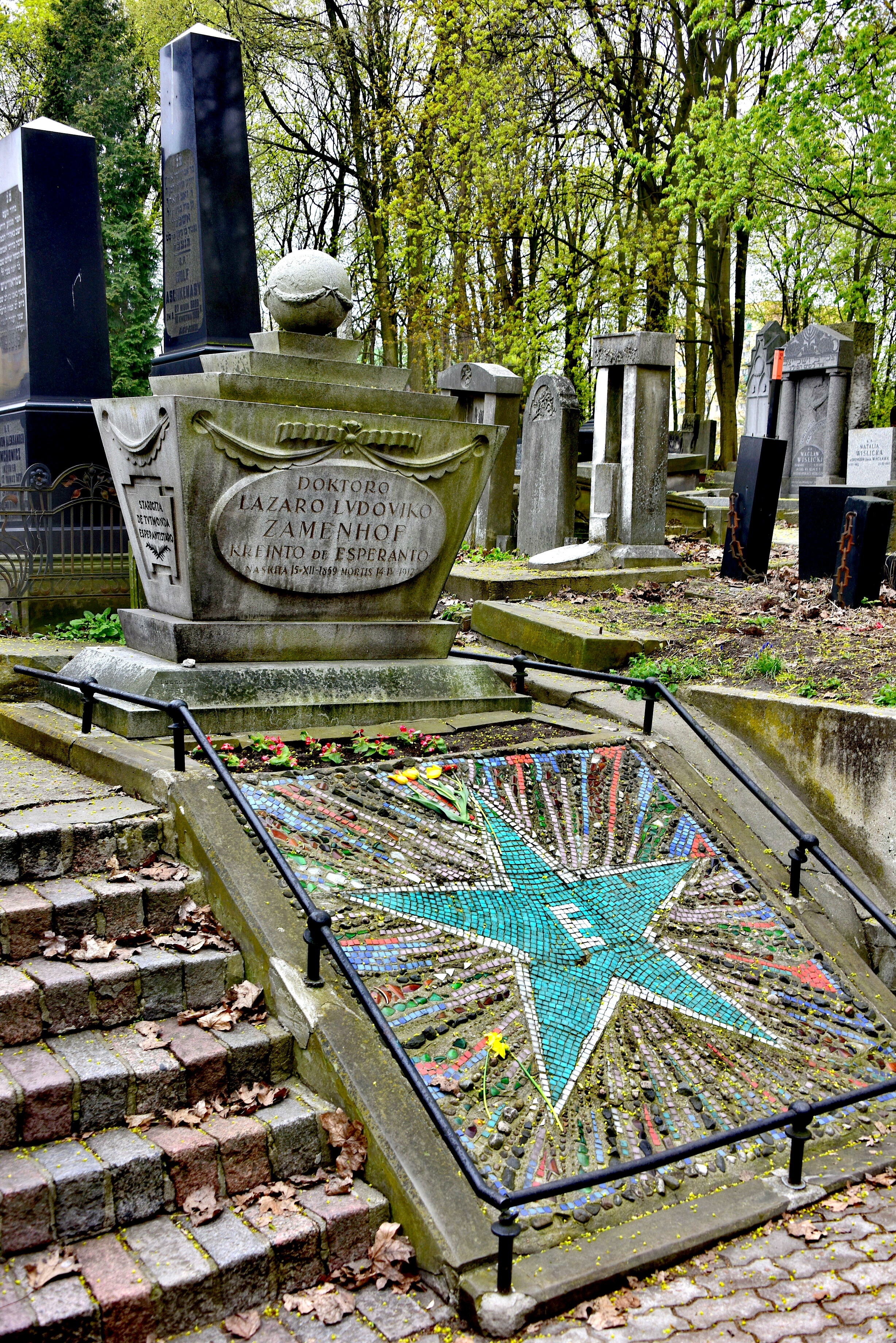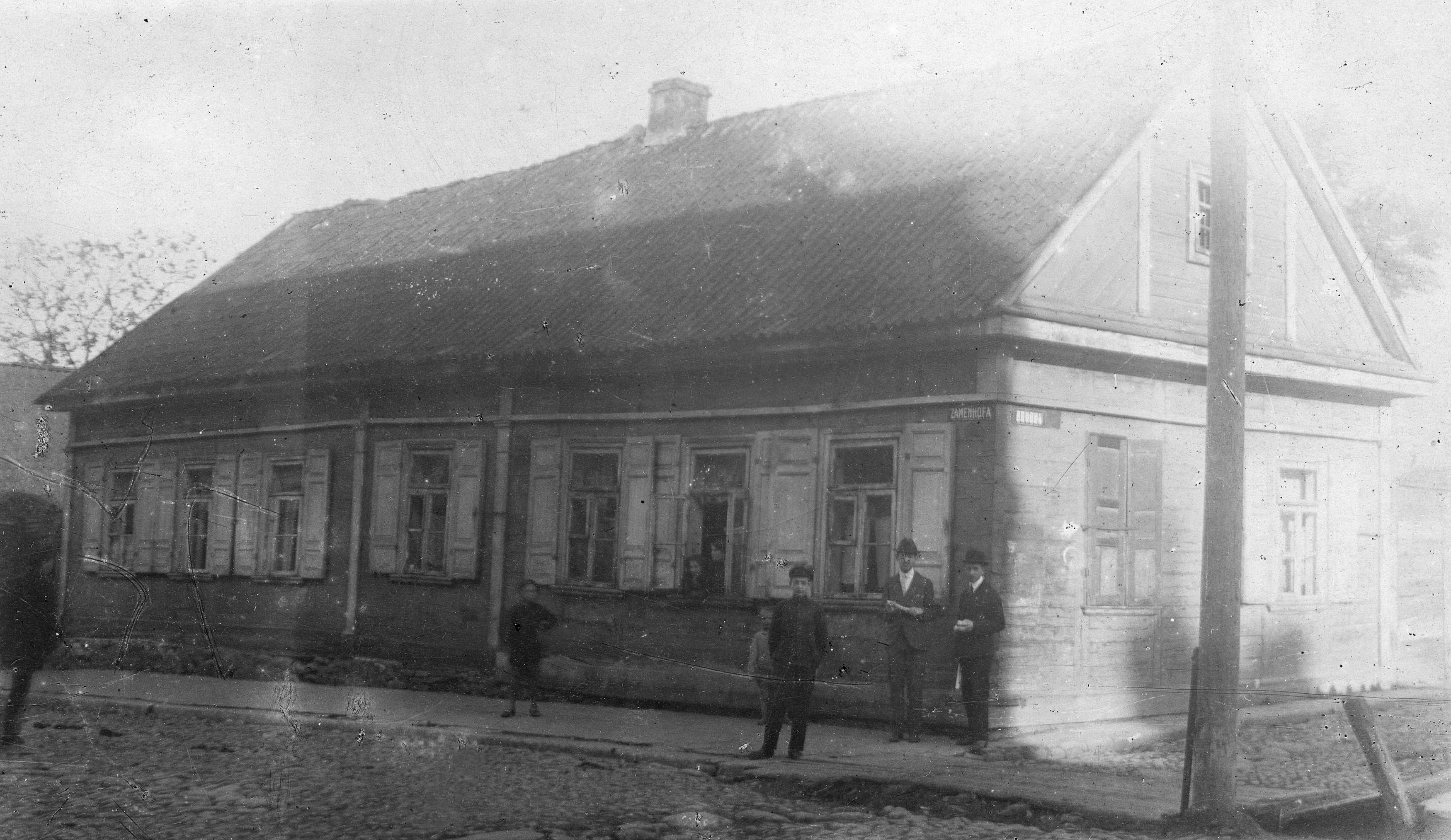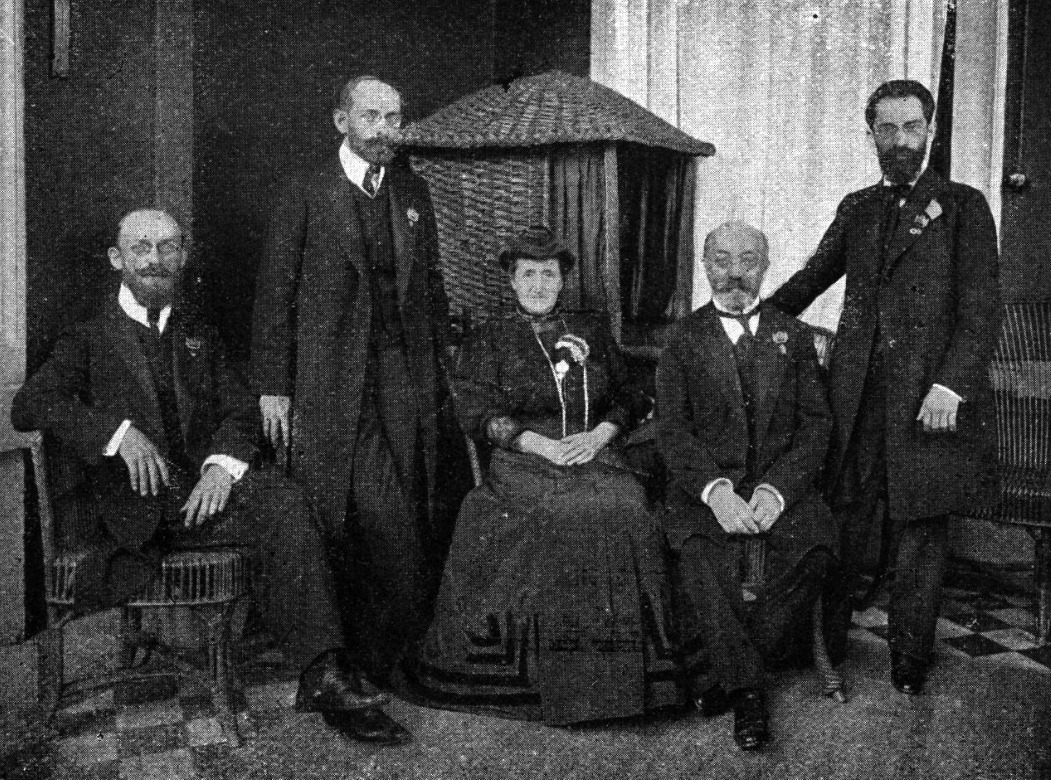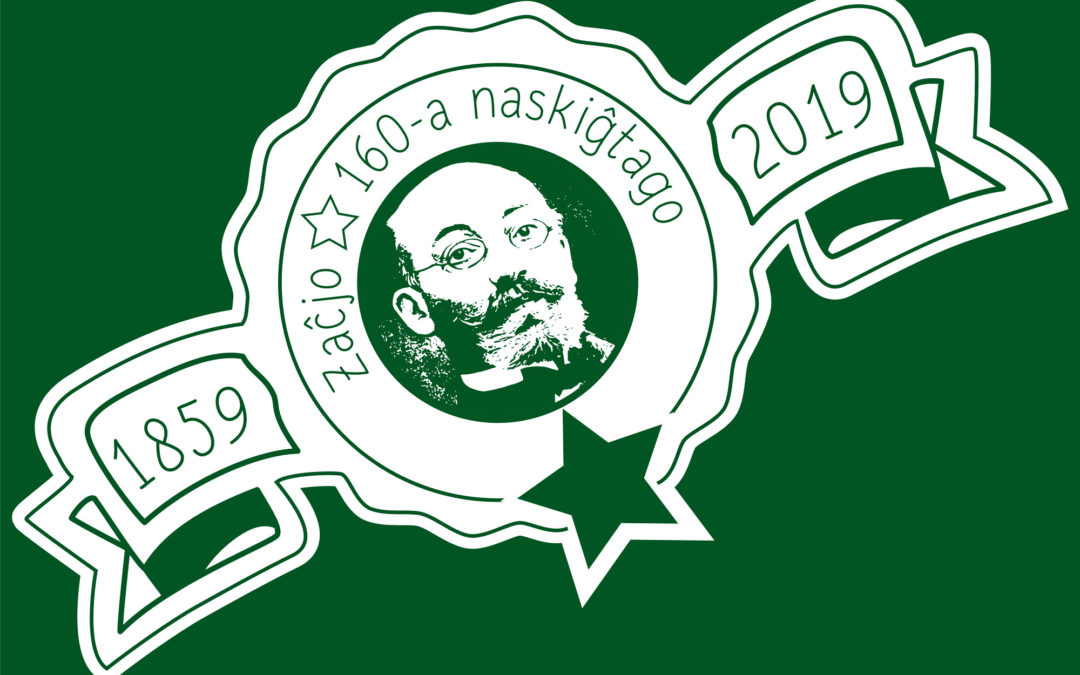By Ian Stephenson
A visitor to the Jewish Cemetery in Warsaw might stumble upon a colourful gravestone unlike the 250,000 others, with its large, green star picked out in mosaic tiles and its cryptic epitaph in a language that is neither Hebrew nor Polish – nor any of the major European languages – but which is somehow reminiscent of them all: Doktoro Lazaro Ludoviko Zamenhof – kreinto de Esperanto.
A visitor who stumbles upon this gravestone around 15 December might also find it piled with candles or stones with some individuals pensively bent over the tomb. It is a special day for a very specific group of linguists – Zamenhof Day – the birth anniversary of the grave’s eternal inhabitant, Dr Ludwik Zamenhof, the father of the international language of Esperanto.

Ludwik Zamenhof’s grave in Warsaw (Wikimedia Commons/Adrian Grycuk – used under CC BY-SA 2.0)
Looking for a neutral communication tool
Born in 1859 in what is today the eastern Polish city of Białystok (then in the Russian Empire), Ludwik Zamenhof grew up to become an ophthalmologist by profession and a linguist by obsession.
The ethnic climate of late 20th-century Białystok saw native Russians, Poles, Jews, Germans, Belarusians and Lithuanians intermingling on a daily basis, and yet Zamenhof was well aware of and saddened by the tensions between the various ethnic groups. He put the trouble down to a single factor: a mutual misunderstanding caused by the overabundance of languages in such a small space. If only a common language existed, he thought, it could play the role of a neutral communication tool between people regardless of their ethnic or linguistic backgrounds.
Zamenhof’s first forays into the creation of an international auxiliary language (he never intended to replace those already in existence) began while he was attending school in Warsaw. His first project Lingwe uniwersala was completed in 1878, but he was then still too young to have his work published. He continued his medical studies and went on to become a practising doctor, all the while fine-tuning and simplifying his fabricated language.
Finally, in 1887, he published the first textbook for his new language under the pseudonym Doktoro Esperanto (“Doctor Hopeful”), and based it upon three basic principles he had observed in his home city:
- “to render the study of the language so easy as to make its acquisition mere play”
- “to enable the learner to make direct use of his knowledge with people of any nationality”
- “to find some means of overcoming the natural indifference of mankind”.
Zamenhof himself called the language lingvo internacia, or international language, but his followers soon took to using his pseudonym to refer to his work, and it became popularly known as Esperanto. It was so successful that the first textbook, Unua libro (“First Book”), was translated into Hebrew, Yiddish, Swedish, Lithuanian, Danish, Bulgarian, Italian, Spanish and Czech within the first two years.
The linguistic contest between Esperanto and Volapük
Zamenhof’s Esperanto was in no way the first attempt at creating an internal auxiliary language. Immediately after publication, he had to face down his biggest linguist competition: Volapük, the invention of a German Catholic priest, Johann Martin Schleyer. Zamenhof and Schleyer’s rivalry was a heated one, with advocates of each arguing the cases for and against their preferred language in the press.
But it was Esperanto which won, thanks to its streamlined simplicity. Esperanto’s vocabulary consists of words with recognisable Latin and Germanic roots, whereas Volapük referred to Old English and, in many cases, the completely arbitrary decisions of its creator. Esperanto’s grammar held firmly to the familiar rules of French, German and English, while Volapük diverted from long-established norms. Esperanto’s generous use of two dozen suffixes and prefixes to modify the meaning of a single root word defeated Volapük’s sometimes convoluted and forced syntax.
Esperanto picked up enough steam in the 1890s for Zamenhof – with some thousands of fluent speakers of Esperanto now at his side – to declare victory over Volapük. It was at this point that the doctor’s characteristic modesty and stoicism gave way to a rare bout of pride by including the scathing entry Ĝi estas por mi volapukaĵo (“It’s Volapük to Me”) in the section subtitled “Gibberish” of his 1910 publication Proverbaro Esperanta (“Esperanto Proverbs”).

The Zamenhofs’ family home in Białystok
“Esperanto belongs to no one”
The beginning of the 20th century was a turning point for the international Esperanto movement, with support from international authorities like Leo Tolstoy. The Russian author lauded the doctor on the creation of a complete language which can be learned “in no more than two hours of careful study”.
Zamenhof’s crowning moment came at the first World Esperanto Congress in 1905. Some 700 Esperantists descended on Boulogne-sur-Mer in northern France to sign the Declaration of Boulogne which recognised “that Esperanto is the most realistic international auxiliary language that exists” and that, in accordance with Zamenhof’s initial wishes, “Esperanto belongs to no one”.
And yet what went up must also come down. With only three years of his life left, Zamenhof became witness to the moment when the Esperanto movement tipped over its zenith and began its plunge into relative obscurity. The most galling – at least for the doctor – testament to the widespread success of Esperanto, one which flew in the face of all the principles behind Esperanto, came in the first years of the First World War.
In 1915, the German forces began air-dropping propaganda leaflets written in Esperanto into neutral countries. These, entitled La Europa milito – Germanaj oficialaj raportoj Esperantigitaj (“The European War – Official German reports in Esperanto”, with the word “official” thickly underlined), contained communiqués directly from the German command translated into Esperanto.
France responded immediately, and within a week had set up a rival Esperanto committee, whose first translation to be disseminated was de Bunswyk’s Red Book of German Atrocities in Belgium. Esperanto had become a weapon, a means by which to fight the bloodiest war the world had ever seen.
Esperanto’s freefall
Yet as the dust settled over war-torn Europe, and three years after Zamenhof’s death, it seemed that Esperanto might become that tool for peace which its creator had so desired. In 1920, the Iranian delegate to the League of Nations proposed that the language be adopted for international relations. The motion had a majority of 10:1.
Unfortunately, that one vote against belonged to the French delegate, who wielded his veto power to scupper the motion, fearing that his native language was losing international influence. The French government went on to ban Esperanto classes in all school and universities, with the Ministry of Instruction arguing that “French and English would perish and the literary standard of the world [be] debased” by the language.

The Zamenhof family in Dresden, 1908
Esperanto was in freefall from then on. Europe’s 20th-century totalitarian states demonised the language and actively repressed its speakers. Nazi Germany used Zamenhof’s Jewish heritage to condemn the language and judged its universality as “Bolshevik”. Hitler’s Mein Kampf specifically mentions Esperanto as an example of a language that could be used by the international Jewish community after they achieved the perceived “world domination”. Esperantists were cut down in the Holocaust. Zamenhof’s own daughter Lidia was swept up in a mass transport during the Grossaktion Warschau – the clearing of the Warsaw Ghetto – and murdered at the German Nazi extermination camp of Treblinka in 1942.
Esperantists were not any safer in Stalinist Russia. The dictator’s acceptance – or tolerance – of the language ended at the height of the Great Purge in 1937. Many Esperantists were executed, exiled or interned in Gulag camps, having been accused of being “an active member of an international spy organisation which hides itself under the name of ‘Association of Soviet Esperantists’ on the territory of the Soviet Union.”
The 1970s rebirth and African Esperanto conference
Unconquerable, however, Esperanto experienced a certain rebirth in the late 1970s and spread to previously untouched parts of the world, such as its explosion in popularity in Iran in 1975. By the late 20th century, there were enough Esperantists in Africa to enable the first ever pan-African Esperanto conference in 1991.
Where does that leave Esperanto today? Current data show some two million speakers of Esperanto spread around the world, including 2,000 “native” speakers who have learnt the language from birth. It has entered into the education system of Hungary and China. The Chinese government has used Esperanto since 2001 for daily news on its website.
Esperanto is also the first language of teaching and administration of the International Academy of Sciences in San Marino. Wikipedia has over 270,000 pages written in Esperanto, and Duolingo has 1.3 million users learning the language. Shakespeare, Dickens, Dumas, Goethe, Tolstoy, Twain and many others have all been translated into Esperanto.
Esperanto may so far have failed to live up to the hopes of its creator, who dreamed of it becoming a universal second language, but with the shadow of Brexit looming over Europe and the linguistic void its absence will leave in international diplomacy, a romantic might be forgiven for hoping that the time may be right for the life’s work of one of Poland’s most eminent linguists to make an unexpected resurgence.
Main image credit: Eugenio Hansen, OFS/Flickr (under CC BY-SA 2.0)





















